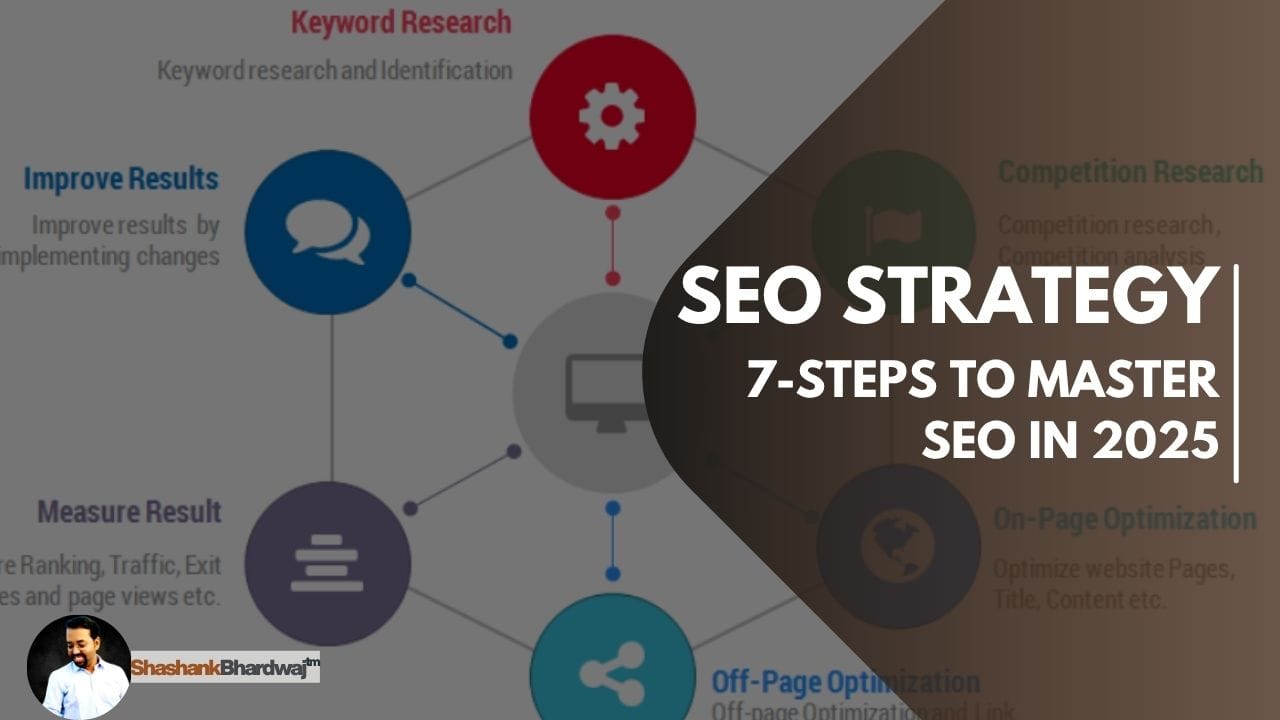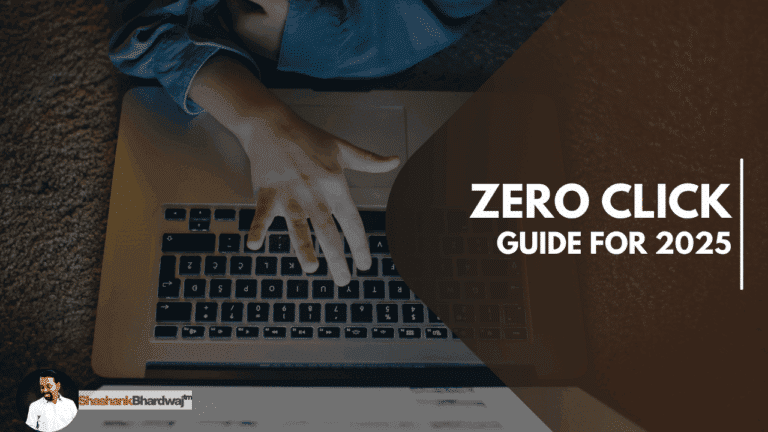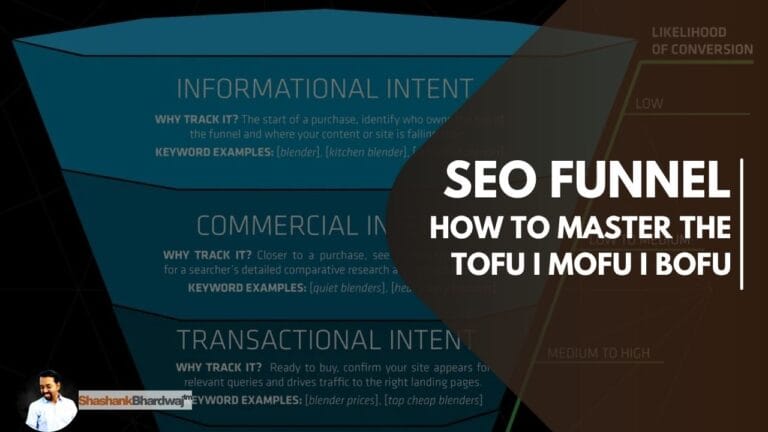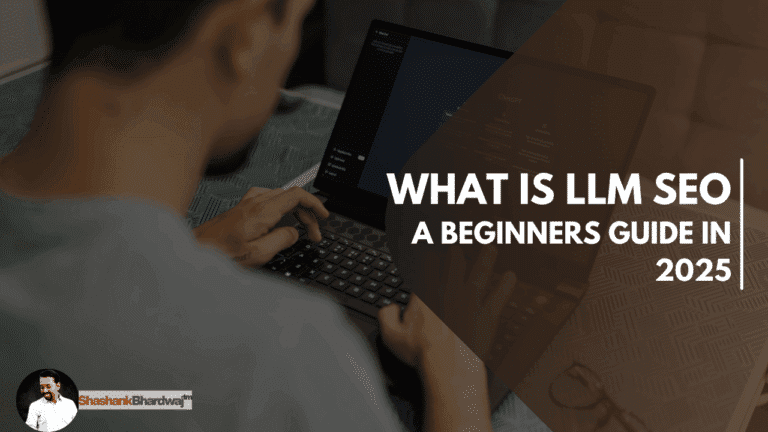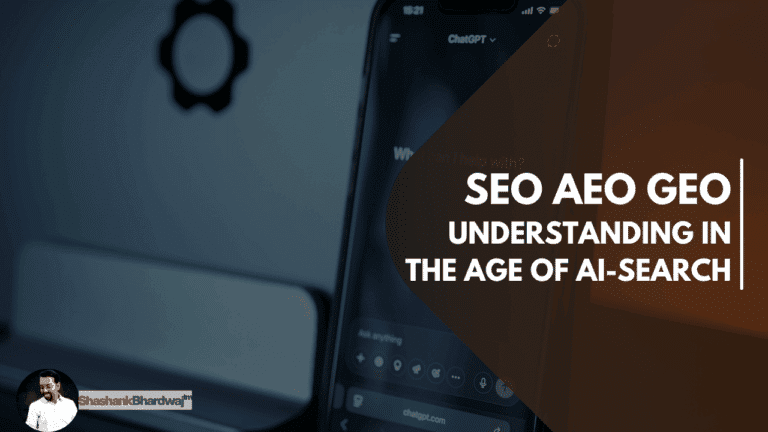A Comprehensive SEO Strategic Plan for Digital Growth – 7 Steps
1.0 The Strategic Imperative of Modern SEO
1.1 Introduction: Defining the Modern SEO Landscape
A successful SEO Strategic Plan is no longer about ‘gaming the system’ with clever tricks. Today, sustainable growth is achieved by building a foundation of quality, authority, and user-centric value that aligns with modern search engine principles. This approach moves beyond simple ranking metrics to focus on attracting, engaging, and converting the right audience. This section defines the core philosophy and operational parameters of a contemporary, results-driven SEO Strategic Plan, distinguishing effective modern strategies from the outdated tactics that no longer yield results.
1.2 The Evolution from Tactical Loopholes to Strategic Value
Understanding the importance of an SEO Strategic Plan can significantly enhance a business’s digital presence and competitiveness in the market.
The digital landscape is in a state of constant evolution, and SEO practices must evolve with it. What worked a decade ago is now ineffective and, in many cases, detrimental to a website’s health. The following table illustrates the critical shift from short-term tactical manipulation to long-term strategic value creation.
| Old SEO (Ineffective Practices) | 2024 SEO (Strategic Pillars) |
| Abusing AI for content generation | A “Quality First” content philosophy |
| Low-quality, thin content | Consistent content audits and upgrades |
| Keyword stuffing and unnatural language | A technically optimized and performant website |
| Acquiring spammy, irrelevant backlinks | Building relevant, authoritative backlinks |
| Attempting to “game the system” | Using AI tools to optimize and enhance strategy |
| Neglecting website design and user experience | A deep focus on matching user search intent |
| Cursory keyword selection | Intense, data-driven keyword research |
1.3 The Core Components of a Modern SEO Strategic Plan
To build a SEO strategic Plan that endures, it is essential to understand the foundational principles that govern search engine rankings. While the specifics of Google’s algorithm are complex and proprietary, its core pillars are centered on delivering the most relevant, trustworthy, and accessible results to users.
Key Pillars of Search Engine Ranking
Foundational & Technical Signals
- Crawlability and Indexing: A site must be technically structured so search engines can easily find, read, and store its content in their index, which is the first step to becoming visible in search results.
- Mobile-Friendliness: With the majority of searches occurring on mobile devices, a seamless and responsive experience on all screen sizes is a non-negotiable ranking factor.
- Page Speed: Fast-loading pages are critical for user satisfaction and are a confirmed ranking signal, directly impacting user engagement and bounce rates.
- Core Web Vitals: These specific metrics measure a page’s loading performance, interactivity, and visual stability, directly quantifying the user’s on-page experience.
- Secure Website (HTTPS): A secure, encrypted connection (HTTPS) is a standard for user safety and a confirmed ranking signal.
- Duplicate Content: Unique, original content is essential, as duplicate content across a site or the web can confuse search engines and dilute ranking potential.
Content & Relevance Signals
- Keyword Relevance: Content must be directly relevant to the keywords and phrases users are searching for, demonstrating a clear connection between the query and the information provided.
- Content Quality: High-quality, original, and valuable content that comprehensively addresses a user’s needs is a primary factor for achieving and maintaining high rankings.
- E-E-A-T (Expertise, Experience, Authoritativeness, Trustworthiness): This framework is central to assessing content quality, requiring content to be created by credible sources with demonstrable expertise and trustworthiness.
- Search Intent Matching: The most successful content is that which perfectly aligns with the underlying reason for a user’s search, whether it’s to learn, find, or buy something.
- Freshness Algorithm: Timely and recently updated content is often prioritized, especially for queries where the latest information is most valuable.
- Content Depth and Length: Comprehensive content that covers a topic in detail is often favored over superficial articles, as it better satisfies user queries.
Authority & Context Signals
- Backlinks (Link Authority): Backlinks from reputable, relevant websites act as votes of confidence, signaling to search engines that a site is an authoritative source of information.
- RankBrain (AI): Google’s AI system helps interpret search queries, especially novel ones, to better understand user intent and deliver more relevant results.
- Schema Markup (Structured Data): Implementing schema helps search engines understand the context of content more deeply, enabling rich results like reviews and FAQs directly in the search listings.
- User Experience (UX): Search engines prioritize sites that are easy to navigate, logically structured, and provide a positive overall experience for visitors.
- Local SEO Factors: For businesses with a physical presence, factors like Google Business Profile optimization, local citations, and geo-targeted content are critical for local visibility.
1.4 Section Conclusion and Transition
Ultimately, the paradigm has shifted decisively towards a quality-first, user-centric approach. This philosophy underpins every aspect of a modern SEO strategy. The first step in applying these principles is to conduct a comprehensive analysis of the current digital assets to establish a data-driven baseline for action.
——————————————————————————–
2.0 Foundational Analysis & Competitive Intelligence
2.1 Introduction: The First Step in Your SEO Strategic Plan
Before implementing any new tactics or launching new campaigns, it is crucial to conduct a thorough diagnostic of the website’s current SEO health. This foundational analysis provides a clear, data-driven baseline, identifies critical issues that may be hindering performance, and offers insights into the competitive landscape. A comprehensive audit is not merely a technical check; it is a strategic exercise to answer the fundamental questions: “Is my SEO working?” and “Where can I improve?”
2.2 The Comprehensive SEO Audit Framework
A systematic analysis ensures that all critical areas of SEO are evaluated. This framework provides a structured approach to identifying both strengths and weaknesses across the entire digital ecosystem.
- Keyword Research: This analysis answers: Are we targeting the right keywords to attract high-intent traffic?
- On-Page SEO: This step answers: Are our pages structured to maximize visibility and user engagement for our target terms?
- Content Quality: This audit asks: Does our content demonstrate true expertise and satisfy the core needs of our audience?
- URL Structure: This analysis ensures that URLs are logical, user-friendly, and structured to support SEO best practices.
- Mobile-Friendliness: This check confirms: Does our website provide a seamless and fully functional experience on all mobile devices?
- Page Speed: This involves analyzing the website’s loading times to ensure they meet performance benchmarks for user retention and rankings.
- Backlink Profile: This review determines: Is our backlink profile a source of authority, or is it holding us back with toxic links?
- Internal Linking: The goal is to analyze the internal link structure to ensure it effectively distributes authority and helps users navigate the site.
- Schema Markup (Structured Data): This analysis checks for the proper implementation of structured data to enhance visibility in search results.
- Image Optimization: This step evaluates whether images are properly sized, compressed, and utilize descriptive alt text for accessibility and relevance.
- Sitemap and Robots.txt: The objective is to confirm these files are correctly configured to guide search engine crawling and indexing.
- Core Web Vitals: This analysis measures the site’s performance against Google’s key user experience metrics for loading, interactivity, and stability.
- Crawlability and Indexing: This step identifies any technical barriers that prevent search engines from accessing and indexing site content.
- Competitor Analysis: The goal is to benchmark performance against key competitors to identify strategic gaps and opportunities.
- Local SEO: For applicable businesses, this analysis evaluates visibility in local search results and the health of local business listings.
2.3 Deconstructing the Competitive Landscape: SERP Analysis
While automated tools provide valuable data, they cannot replace the insights gained from manual analysis of the Search Engine Results Pages (SERPs). This process reveals what content formats, structures, and authority levels are currently succeeding for target keywords.
- Identify Target Keywords: Begin by selecting the primary keyword or phrase you intend to rank for.
- Analyze Top Competitors: Scrutinize the top-ranking pages to understand who the main competitors are and the nature of their content.
- Study Featured Snippets: Examine if a featured snippet is present and analyze its format and content to understand how Google is directly answering the query.
- Look at Domain Authority: Assess the domain authority of the top-ranking sites to gauge the level of competition and the backlink profile required to compete.
- Review Page Load Times: Manually test the loading speed of the top results to understand the performance benchmark for the query.
- Optimize For User Intent: Analyze the angle and format of the top-ranking content (e.g., listicles, how-to guides, product pages) to understand what users are actually looking for.
- Monitor SERP Changes: Regularly revisit the SERPs for key terms, as rankings and features can change frequently.
As a guiding principle for this process: “Don’t just listen to what tools tell you. Go analyze Google yourself.”
2.4 Leveraging Tools for Strategic Insight
Strategic tools can significantly accelerate the analysis and execution phases of an SEO strategy by automating data collection and providing actionable insights.
Strategic Application of Ahrefs
Ahrefs is a comprehensive SEO toolset that provides deep insights into a website’s performance and competitive standing. Its primary applications include:
- Spy on Competitors with Site Explorer: Analyze competitors’ backlink profiles, top pages, and organic keyword rankings.
- Find Winning Keywords in Keywords Explorer: Discover high-value keywords, assess their difficulty, and analyze their SERP potential.
- Discover High-Value Content with Content Explorer: Find the most shared and linked-to content in any niche to inform content strategy.
- Audit Your Website with Site Audit: Automatically scan a website for common technical and on-page SEO issues.
- Track Keyword Performance with Rank Tracker: Monitor keyword ranking progress over time across different locations and devices.
- Build Backlinks with Backlink Analysis: Uncover backlink opportunities by analyzing where competitors are getting their links.
- Uncover Content Gaps with Content Gap Tool: Identify keywords that competitors rank for but you do not, revealing key content creation opportunities.
Streamlining Content Audits with Surfer
Tools like Surfer can simplify and streamline the ongoing process of content optimization. Surfer’s Content Audit feature helps to keep existing pages fresh and competitive by identifying pages that need a refresh and providing weekly, data-backed recommendations for improvement directly to your inbox.
2.5 Section Conclusion and Transition
A comprehensive audit and rigorous competitive analysis form the essential foundation for a targeted and effective SEO strategy. The insights gained from this diagnostic phase directly inform the architecture of a high-intent keyword strategy, which serves as the blueprint for all subsequent content and optimization efforts.
With a data-driven baseline established, the next phase of our SEO Strategic Plan involves architecting a high-intent keyword and content funnel.
——————————————————————————–
3.0 Architecting a High-Intent Keyword and Content Funnel Strategy
3.1 Introduction: The Cornerstone of SEO Success
Keyword research and prioritization is the single most important activity in SEO. Without a clear understanding of what your audience is searching for and why, any content created lacks a strategic purpose. This section outlines a systematic approach to not only identify relevant keywords but to categorize them according to user intent and deploy them strategically across the customer journey. This ensures that content serves to build awareness, facilitate consideration, and ultimately drive conversions.
3.2 Evaluating the Spectrum of SEO Keywords
An effective strategy leverages a diverse portfolio of keyword types, each serving a distinct purpose in attracting and engaging users at different stages of their journey.
- Short-Tail & Long-Tail Keywords:
- Short-Tail: Broad, 1-2 word phrases (e.g., “SEO strategy”) with high search volume but often high competition and vague intent. They are useful for building broad awareness.
- Long-Tail: Longer, more specific 3+ word phrases (e.g., “SEO strategy for b2b saas companies”) with lower volume but higher conversion intent. They are crucial for capturing qualified traffic.
- Branded & Non-Branded Keywords:
- Branded: Keywords that include a specific brand name (e.g., “Ahrefs keyword explorer”). They are used by people already familiar with the brand.
- Non-Branded: Keywords that do not include a brand name (e.g., “best keyword research tool”). They are used to attract new users who are not yet brand-aware.
- Informational, Navigational, & Transactional Keywords:
- Informational: Used when a person is looking for information (e.g., “what is SEO”). These are ideal for top-of-funnel content like blog posts.
- Navigational: Used to find a specific website (e.g., “LinkedIn login”). The intent is to go to a known destination.
- Transactional: Used when a person is ready to make a purchase or take a specific action (e.g., “buy SEO course”). These keywords have high commercial intent.
- Buyer Intent Keywords: A subset of transactional keywords that strongly indicate a user is close to making a purchase (e.g., “Surfer SEO pricing”). These are high-priority targets for conversion-focused pages.
- Geo-Targeted Keywords: Keywords that specify a location (e.g., “SEO consultant in New York”). They are essential for local SEO and attracting customers in a specific geographic area.
- Competitor Keywords: Keywords that include a competitor’s brand name. Targeting these can be a strategy to capture users who are evaluating alternative solutions.
- LSI Keywords (Latent Semantic Indexing): Thematically related terms and phrases that help search engines understand the context of a page more deeply (e.g., for a page about “cars,” LSI keywords might include “engine,” “tires,” “driving”).
- Seasonal Keywords: Keywords related to specific holidays, seasons, or events (e.g., “Black Friday deals”). They are valuable for capturing timely traffic during periods of high demand.
3.3 The Bottom-Up Content Funnel Strategy
The SEO content funnel mirrors the traditional marketing funnel, with stages designed to address different levels of user awareness and intent: Top of Funnel (TOFU), Middle of Funnel (MOFU), and Bottom of Funnel (BOFU). While it may seem intuitive to build from the top down, a more effective and revenue-focused approach is to “Go from the bottom up.”
This strategy prioritizes capturing users with the highest purchase intent first, generating immediate business value that can then fuel further content investment.
- BOFU (Bottom of Funnel): The primary focus is to “Hit BOFU first & capture paying customers.” This involves creating content and pages targeting transactional and buyer-intent keywords. The goal is to convert users who are actively looking to make a decision.
- MOFU (Middle of Funnel): Once the BOFU foundation is in place, the focus expands to target “customers in the research phase.” This content addresses comparison keywords, “best of” lists, and case studies, helping to guide users who are evaluating their options.
- TOFU (Top of Funnel): The final stage is dedicated to building “subject matter expertise” and brand authority. This involves creating informational content like blog posts, guides, and articles that answer broader questions, adding more people to the top of the funnel for future nurturing.
This bottom-up approach ensures that the strategy prioritizes generating revenue first, after which it can expand its focus to building broader reach and brand awareness.
3.4 Section Conclusion and Transition
A structured, funnel-based keyword strategy serves as the essential blueprint for all content creation activities. It ensures that every piece of content has a clear purpose and contributes to the overarching business goals. The next step is to execute this blueprint through meticulous on-page and content optimization, translating strategic intent into tangible on-site assets.
This funnel-based keyword blueprint is the heart of your SEO Strategic Plan, and the next step is to execute it through meticulous on-page optimization.
——————————————————————————–
4.0 On-Page and Content Optimization Blueprint
4.1 Introduction: Translating Strategy into On-Site Execution
On-page optimization is the process of embedding the keyword and content funnel strategy directly into the website’s digital assets. This is where strategic plans become tangible realities. This section provides a tactical blueprint for ensuring that every piece of content—from foundational blog posts to dynamic videos—is perfectly optimized to be found by search engines and to provide maximum value to users.
4.2 Establishing the Content Hub: The SEO Blog
A well-structured blog is a powerful engine for SEO content and sustainable growth. It serves as the primary hub for publishing keyword-targeted, informational content that attracts users at the top and middle of the funnel.
The following six foolproof steps outline the process for launching an effective SEO blog:
- Get a website host: Secure reliable hosting that ensures your site is fast and accessible.
- Choose a CMS: Select a Content Management System (like WordPress) that is user-friendly and SEO-compatible.
- Make a blog page: Create a dedicated, well-designed home for all your blog content.
- Create categories: Organize posts into logical categories to improve user navigation and site structure.
- Link to it internally: Ensure the blog is prominently linked from the main website navigation to pass authority and drive traffic.
- Publish a first post: Launch the blog with a high-quality, optimized piece of content to set the standard for future publications.
Despite claims to the contrary, blogs “still rank at the top of Google and drive millions in traffic every day,” making them a cornerstone of modern content strategy.
4.3 Core On-Page Optimization Elements
Meticulous attention to on-page details can significantly impact click-through rates and rankings.
- Title Tags: The title tag is a user’s first impression in search results. To write killer SEO title tags, adhere to these principles: keep it under 60 characters, place the primary keyword early in the title, include the brand name where appropriate, and create unique, descriptive titles for every single page.
- Meta Descriptions: While not a direct ranking factor, a compelling meta description entices users to click. Core principles include keeping it concise, including target keywords naturally, using action-oriented language, clearly matching the user’s search intent, and writing for humans, not just search bots.
- Image Alt Text: Alt Text is a short description that serves two key functions: it makes images accessible to visually impaired users, and it lets Google “interpret” the image’s relevance to the surrounding content. Key rules for effective alt text include being descriptive and specific, keeping it short, including keywords naturally, and avoiding redundant phrases like “Image of” or “Picture of”.
4.4 Advanced Content Optimization: Video SEO
As video emerges as a “TOP format for social media content,” optimizing video assets for search is no longer optional. The growing dominance of this format is evident in platforms like LinkedIn, which is now prioritizing video with a dedicated content feed, making video optimization an essential part of a modern SEO strategy. A comprehensive approach must include tactics specifically for video.
- Use keyword-rich video titles: Create descriptive titles that include the primary target keyword.
- Write detailed video descriptions: Use the description field to provide context, include secondary keywords, and add relevant links.
- Optimize video thumbnails: Design compelling, high-quality thumbnails that accurately represent the video content and entice clicks.
- Enable closed captions: Upload a transcript to make the video accessible and provide search engines with more text to crawl.
- Embed videos above the fold: Place important videos in prominent positions on the page to maximize engagement.
- Optimize for mobile viewing: Ensure videos are responsive and provide a seamless viewing experience on all mobile devices.
- Improve video loading speed: Host videos on platforms optimized for speed or use solutions that prevent slow page loads.
- Utilize schema markup for videos: Implement video schema to help search engines understand the content and display rich results.
4.5 Maintaining Asset Value: Content Audits and Upgrades
A common strategic mistake is to focus exclusively on creating new content while neglecting the vast potential of existing assets. The reality is, “There’s ALWAYS content to upgrade.” A regular content audit helps identify pages with declining traffic, outdated information, or new optimization opportunities. Keeping pages “FRESH” by updating them with new data, insights, and better optimization is a highly efficient way to maintain and improve rankings.
4.6 Section Conclusion and Transition
Meticulous on-page and content optimization are necessary to translate a keyword strategy into ranking performance. These on-site signals tell search engines what a page is about and why it is valuable to users. However, while on-page factors are critical, a site’s true authority in the eyes of search engines is largely built through off-page factors like backlinks.
Meticulous on-page optimization is what brings the blueprint of your SEO Strategic Plan to life, translating strategic intent into tangible on-site assets.
——————————————————————————–
5.0 Authority Building through a Strategic Backlink Program
5.1 Introduction: The Power of Off-Page Authority Signals
Off-page SEO, primarily through the acquisition of backlinks, is a critical component of any successful strategy. As the source material states, “Backlinks and Content go hand in hand for SEO.” A backlink from another website acts as a third-party vote of confidence, signaling to Google that your content is credible, valuable, and authoritative. A robust backlink profile not only builds trust with search engines but is also a powerful driver of ranking improvements and referral traffic.
5.2 The Business Impact of a Strong Backlink Profile
Building high-quality backlinks delivers tangible business results that extend far beyond simple ranking increases. Each new authoritative link contributes to a compounding cycle of growth and visibility.
- They Increase DR (Domain Rating): A higher Domain Rating is a metric correlated with a stronger ability to rank for competitive keywords, enhancing the entire site’s SEO potential.
- They Drive New Traffic: Relevant backlinks from high-traffic sites act as a direct source of referral traffic, introducing your brand to new, qualified audiences.
- They Gain New Keyword Ranking: Backlinks pass authority to your pages, providing the necessary “link equity” to rank for previously unattainable keywords.
- They Build Trust w/ Google: A profile of links from authoritative sources is one of the strongest signals that a website is trustworthy and a legitimate leader in its field.
- They Grow Your Brand: Being featured on other reputable websites increases brand visibility and positions the company as a subject matter expert.
- They Create New Leads: Referral traffic from relevant industry sites is often highly qualified, leading directly to new leads and potential customers.
- They Battle Competition: A superior backlink profile is a significant competitive advantage that is difficult for rivals to replicate, creating a sustainable barrier to entry.
5.3 Guiding Principles for Backlink Acquisition
Modern link building prioritizes quality over quantity. The strategic focus must be on acquiring “Relevant, authoritative backlinks” from websites that are topically aligned with your own. The era of spammy, low-quality link schemes is over; such tactics now carry significant risk of penalties. An effective, modern approach involves earning links through high-value content and strategic outreach. One powerful and actionable tactic is to “Find broken links on authority sites and offer your content as a replacement,” providing value to the other site while earning a valuable link.
5.4 Section Conclusion and Transition
A high-quality, relevant backlink profile is a non-negotiable component of any strategy aiming for long-term SEO success and market leadership. It solidifies a website’s authority and amplifies the impact of all content efforts. However, both world-class on-page content and a powerful off-page backlink profile rely on a technically sound and high-performing website foundation.
A strategic backlink program is a non-negotiable pillar of any authoritative SEO Strategic Plan, amplifying the impact of all other efforts.
——————————————————————————–
6.0 Technical SEO for Peak Performance and User Experience
6.1 Introduction: The Foundation of Search Visibility
Technical SEO is the essential foundation upon which all content creation and authority-building efforts are built. It encompasses the work done to ensure a website can be efficiently crawled, indexed, and understood by search engines. Without a solid technical framework, even the most brilliant content may go unseen by both search bots and potential customers, rendering all other strategic efforts ineffective.
6.2 Core Technical Performance Indicators
Maintaining a technically healthy website is an ongoing process that requires attention to several key performance areas. These elements ensure the site is accessible to search engines and provides a superior experience for users.
- Crawlability and Indexing (Sitemap and Robots.txt): A well-structured XML sitemap acts as a roadmap for search engines, helping them discover all important pages. The robots.txt file provides instructions to search crawlers about which pages or sections of the site to avoid, ensuring crawl resources are used efficiently.
- Page Speed and Core Web Vitals: Page speed is a critical factor for user experience and a confirmed ranking signal. Core Web Vitals are specific metrics that measure a page’s loading performance (Largest Contentful Paint), interactivity (First Input Delay), and visual stability (Cumulative Layout Shift), directly impacting how users perceive the site’s performance.
- Mobile-Friendliness: A responsive website design that adapts seamlessly to all screen sizes is mandatory. Google uses mobile-first indexing, meaning it predominantly uses the mobile version of the content for indexing and ranking.
- Secure Website (HTTPS): Implementing HTTPS encrypts data between the user’s browser and the website, protecting user privacy and building trust. It is a standard security protocol and a minor ranking factor.
- Schema Markup (Structured Data): Schema is a form of microdata that, once added to a webpage, creates an enhanced description (commonly known as a rich snippet), which appears in search results. It helps search engines understand the meaning and context of your content, leading to better visibility.
- URL Structure: Clean, logical, and descriptive URLs are beneficial for both users and search engines. They should be easy to read and ideally include relevant keywords, providing clear context about the page’s content.
6.3 Section Conclusion and Transition
Ensuring ongoing technical health is fundamental to achieving and sustaining peak SEO performance. A technically optimized site provides a seamless experience for search engine crawlers and human visitors alike. Once a site is technically sound and is effectively attracting organic traffic, the final strategic imperative is to convert that hard-won traffic into tangible business outcomes.
——————————————————————————–
7.0 Converting Traffic into Business Value: A CRO Framework
7.1 Introduction: Beyond Traffic—The Conversion Imperative
Attracting organic traffic is a primary goal of SEO, but it is only the first step. The ultimate measure of success lies in converting that traffic into meaningful business results. As the source material aptly states, “Driving SEO traffic is cool, But creating conversions is cooler.” Businesses cannot survive on traffic alone; they require leads, customers, and revenue. This section outlines actionable Conversion Rate Optimization (CRO) tactics to ensure that the traffic generated by SEO translates into measurable value.
7.2 Actionable On-Site Conversion Tactics
A strategic placement of calls-to-action (CTAs) and offers across the website can dramatically increase the likelihood of a visitor taking a desired action.
Lead Capture & Offers
- Join the newsletter CTA: A simple, low-friction way to capture leads and build an audience for ongoing marketing.
- Free downloads in header & footer: Offer high-value content like e-books or checklists in prominent, site-wide locations.
- Exit intent high-value offer: Present a compelling offer to visitors just as they are about to leave the site to recapture their attention.
- Free calculators: Interactive tools like calculators provide immediate value and can be an effective lead generation mechanism.
- Sign up form: Clearly visible and easy-to-use forms for service sign-ups or trial requests.
Direct Engagement
- Free consultations: Offer a direct path for qualified leads to speak with a sales or product expert.
- Get a callback: Provide a simple form for users to request a phone call at their convenience.
- Phone number to call: Make a business phone number prominent and clickable, especially for mobile users.
Building Trust
- Reviews, reviews, reviews: Prominently display customer testimonials, case studies, and third-party reviews to build social proof and credibility.
Content Integration
- Sticky offer on blogs: A persistent banner or CTA that remains visible as a user scrolls through a blog post.
- Offers w/in blog content: Embed relevant CTAs and offers directly within the body of articles where they are contextually appropriate.
7.3 The Role of UX in Conversions
Ultimately, the effectiveness of any CRO tactic is deeply intertwined with the overall user experience (UX) and design of the website. A poor design can undermine even the most compelling offer. In digital marketing, conversions “boil down to your WEB DESIGN.” This isn’t just theory; it’s a lesson learned over a decade of hands-on experience, from scaling an eCommerce business to designing client websites. A modern, thoughtful, and user-centric design that speaks directly to the target customer is not just an aesthetic choice; it is a strategic necessity. A superior user experience should “lead the way to more CONVERSIONS.”
7.4 Section Conclusion and Transition
Integrating a robust CRO framework into an SEO strategy is essential for demonstrating return on investment and turning website traffic into sustainable business growth. The following case study provides a real-world example of how these integrated strategies—from technical analysis and content creation to on-page optimization—combine to produce dramatic, measurable results.
——————————————————————————–
8.0 Blueprint for Success: A Case Study in SEO Growth
8.1 Introduction: Synthesizing Strategy into Real-World Results
This section deconstructs a real-world example of successful SEO execution to illustrate how the strategic principles outlined in this document combine to deliver substantial growth. This case study moves beyond theory to demonstrate the tangible impact of a focused, multi-faceted SEO campaign on keyword rankings, organic traffic, and overall search visibility over a six-month period.
8.2 The 5-Step Strategic Implementation Process
A systematic and prioritized approach was used to achieve significant improvements for an SEO client, growing their top 3 keyword rankings from 55 to over 275 in just six months. The process followed five deliberate steps:
- Step #1: SEO Analysis: The campaign began with a comprehensive audit to identify key issues and strategic opportunities, establishing a clear baseline for action.
- Step #2: BOFU Content Focus: Following the bottom-up funnel strategy, the initial focus was on creating and optimizing content for bottom-of-funnel keywords to capture users with high purchase intent.
- Step #3: New MOFU Content: Once the BOFU foundation was established, the strategy expanded to creating new middle-of-funnel content to engage users in the research and consideration phase.
- Step #4: Internal Linking Update: A strategic overhaul of the site’s internal linking structure was performed to better distribute page authority and improve user navigation.
- Step #5: Design Implementation: Improvements to the website’s design were implemented to enhance user experience and support conversion goals.
8.3 Quantifying the Results
The focused, five-step implementation process produced significant, measurable growth across key performance indicators over the 6-month campaign:
- Top 3 Keyword Rankings: Grew from 55 to over 275, demonstrating a dramatic increase in high-visibility positions.
- Organic Traffic: Increased from 38K to 70K monthly visitors, representing an 84% increase.
- Search Impressions: Grew by 67.6%, indicating that Google was showing the site for a much wider range of queries and recognizing its increased overall authority.
8.4 Final Strategic Takeaway
This case study brings to life the power of SEO when it is done right—strategically, systematically, and with a relentless focus on quality and user intent. It serves as a powerful reminder that continuous effort yields compounding results. The final and most important takeaway from this entire strategic plan is a principle of constant improvement: “Remember, even if your SEO is performing already, There’s always room for improvement.”
